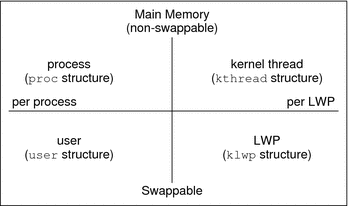| Previous | Next |
1. Managing Terminals and Modems (Overview)
2. Setting Up Terminals and Modems (Tasks)
3. Managing Serial Ports With the Service Access Facility (Tasks)
4. Managing System Resources (Overview)
5. Displaying and Changing System Information (Tasks)
8. Scheduling System Tasks (Tasks)
9. Managing System Accounting (Tasks)
10. System Accounting (Reference)
11. Managing System Performance (Overview)
What's New in Managing System Performance?
Where to Find System Performance Tasks
System Performance and System Resources
About Monitoring System Performance
12. Managing System Processes (Tasks)
13. Monitoring System Performance (Tasks)
14. Troubleshooting Software Problems (Overview)
16. Managing Core Files (Tasks)
17. Managing System Crash Information (Tasks)
18. Troubleshooting Miscellaneous Software Problems (Tasks)
19. Troubleshooting File Access Problems (Tasks)
20. Resolving UFS File System Inconsistencies (Tasks)
Processes and System Performance
The following table describes terms that are related to processes.
Table 11-1 Process Terminology
Term |
Description |
|---|---|
Process |
Any system activity or job. Each time you boot a system, execute a command, or start an application, the system activates one or more processes. |
Lightweight process (LWP) |
A virtual CPU or execution resource. LWPs are scheduled by the kernel to use available CPU resources based on their scheduling class and priority. LWPs include a kernel thread and an LWP. A kernel thread contains information that has to be in memory all the time. An LWP contains information that is swappable. |
Application thread |
A series of instructions with a separate stack that can execute independently in a user's address space. Application threads can be multiplexed on top of LWPs. |
A process can consist of multiple LWPs and multiple application threads. The kernel schedules a kernel-thread structure, which is the scheduling entity in the SunOS environment. Various process structures are described in the following table.
Table 11-2 Process Structures
Structure |
Description |
|---|---|
proc |
Contains information that pertains to the whole process and must be in main memory all the time |
kthread |
Contains information that pertains to one LWP and must be in main memory all the time |
user |
Contains the “per process” information that is swappable |
klwp |
Contains the “per LWP process” information that is swappable |
The following figure illustrates the relationships among these process structures.
Figure 11-1 Relationships Among Process Structures

Most process resources are accessible to all the threads in the process. Almost all process virtual memory is shared. A change in shared data by one thread is available to the other threads in the process.
| Previous | Next |